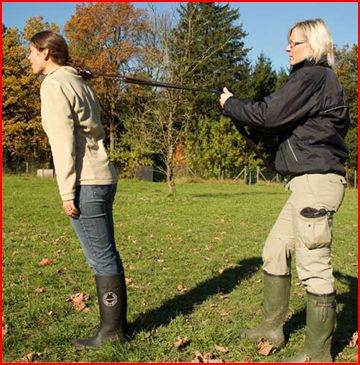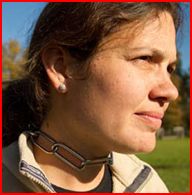Within the last years we observe more and more dogs that are lead with assistance of a harness and formerly those dogs used to wear collars almost every time. Therefore we are often asked to recommend a type of the dog collar.
Our answer to this question
is clear: only the harness!
The reasons of this point are the next:
The harness protects health of the dog, especially its entire neck area from
getting affected. As a result, the fragile cervical
vertebrae, which are exposed to extreme stress, are
preserved when wearing a collar, because not only spine may
be affected, but any pressure or a shift may cause more
continuous movement throughout the body, because the dog's
body is bent. In addition, the trachea and the larynx are
overloaded, so a drawing (or pulling!) made dog groan and
cough.
But this is not the only
problem, because, like all state structures of the larynx,
it is not simply free in the neck and throat area, but is
embedded in a soft tissue. The most important soft tissue
(unfortunately often overlooked in its function and
importance) is the connective tissue and connective tissue
structures linking our entire body. This leads to a
long-range effect on the entire body when it is acted at one
point. It is as if you pull a tablecloth: not only the part
where we move, moves, but the rest of the cover.
When dog owner jerks the
leash or pulls the collar (up to a certain extent, but
significantly attenuated, even when pulling in a harness),
this means that the dog owner acts upon more distant tissue.
This tissue is (usually) not directly injured mechanically,
but responds to stimuli (to jerk a leash - to train) with a
neuro-reflex chain, sitting there in his numerous receptors
that are responsible for responding to actions. That is why
it is called a neuro-reflex loop.
When it comes to unpleasant stimuli, the tension increases in the tissue,
which continue along the connective tissue on and so acts to
other structures. Since the connective tissue also surrounds
nerves, blood vessels and lymphatic channels, a tension
increase leads to a deterioration of the blood and lymph
flow circulation and possibly to stimulation of the nervous
tissue that can lead to the inflammation after that.
Especially in the neck area, there are many delicate
structures: the larynx that can be injured by a direct
mechanical action, such as the leash jerk, situated a little
further above the hyoid bone, which is also a sensitive
muscles area of the larynx, the lower jaw, tongue, the
breast bone, the pharynx and a cartilaginous connection that
leads directly to the skull!
Finally now it is clear
that in addition the direct local effects and remote effects
are expected during the manipulation of the collar, because
the above-mentioned muscles run partly in the neck. Impacts
on these muscles can lead to so-called wounding chains
(tension to increase along the bound movement chains), they
also increase the tension and subsequently structural damage
in other tissues. In the area of the upper cervical joints a
case of malfunctions as dizziness, nausea, blurred vision
and even come tinnitus may appear.
Other symptoms include
disturbances in the upper cervical vertebra (C0-C2) the
concentration and perception problems, nervousness, fatigue,
problems with the jaw, eyes and ears and headaches. Among
the symptoms of disorders of the lower cervical spine
(C3-C7) one may observe lameness in the forelimbs. Often a
change in posture can be observed when the head is carried
low to avoid the pain. It is known that the most common
disruptions in the cervical vertebra are dizziness and
balance problems. In addition, there are the fascia
(connective tissue also) connections to the thyroid and
parathyroid. That is why the collar should not lie directly
on the thyroid in order not to influence it.
Furthermore a major vein
runs in the jugular groove. There is a pressure built up by
a collar, there is a venous back pressure into the skull
leading to an increase in pressure and as a result to these
headaches. Just in 2006 the study "Effects of the
Application of Neck Pressure by a Collar or Harness on
Intraocular Pressure in Dogs" was published, the results
clearly show that dogs that wear collars are more prone to
glaucoma and cataracts. Similarly, the study noted that in
diseases of the eye, an increased IOP (intraocular pressure)
is responsible that the wearing a collar can become fatal.
There are many other anatomical structures that are negatively affected by a collar and cause pain:
Arteries, veins, cranial nerves, esophagus, trachea, lymph nodes and thyroid. The problem, however, is that their damage can not be seen as obvious as for example a broken leg. Dogs can't tell us if there is a pain in the neck. We can know it only from the symptoms: often dog can’t swallow, a slight slopes of the eyelid is seen or pupils are constricted.
To understand above said symptoms properly, we suggest the following experiment: put a wide and soft collar on yourself, attach a leash and ask a friend to hold it while you set forward your center of gravity (1).


The argument of many dog owners that their dogs never pull on the leash and therefore there is no danger, turns out to be always wrong, because even a well-trained dog is indeed not solely responsible for the leash, but is always dependent on the people in the other end of the leash, it is likely to happen at any time that he unconsciously plays around with the leash as the dog is lost in thought moves, because he has not noticed that this would remain as stand to urinate and so on and so forth.
But besides the health
aspects there are other reasons, why a harness should be used
instead of a collar. If your dog must be pulled out once in dangerous situation, you may do so stable with the harness
easily without choking it. It is not possible in the collar,
for example, to pull simply the dog out of a bay or river
without being thereby inflicting damage to health. In dogs
encounters that run with a certain tension, you can also use
the harness much better than the collar, because in order to
engage in this, you need coming from the top take in the neck
of the dog, which can be quickly interpreted by the dog as an
attack. This in its turn can cause from the heat of a battle
to defense responses.
Furthermore, dogs learn among other things association, which means that it has a charm that they perform connection mentally with the feeling that they have at this time. If you are together with another dog, a child or even your neighbors and your dog feels uncomfortable in the collar (e.g. it is difficult to breathe or it is painful, etc.), the dog will associate the discomfort with this animal or person. Thus within a short time the aggression may arise, and the holder won't be able to explain it, but this aggression is due to this thought pattern. The resulting best-known form of aggression is the leash aggression, which is especially common among dogs that are working on the collar by the leash shift.
Many dog experts stress that
the neck of the dog is an important social destination for
positive and negative strokes. The sides of the dog neck are
used for contact with close friends in trusting relationships,
the neck and the throat are used as areas of classification.
If we introduce the dog to more comfortable collar, it cannot
prevent the wrong information flow through the leash to the
dog. We cannot keep our hands so quiet that the leash sag
stays always easy.
Many dog owners think why their dog is unconscious by scrabbling around on a leash and plucking a mess to transmit signals and so he learns to ignore this soon. His "social receiving station" blunts and he learns that it is difficult to communicate with people! The body language of the dog that is drawn or pulled heavily on the leash is changing when he is out of the collar. The posture is provocative, because the neck is stretched upward. In some cases, the owners hold the leash even so tight that the dog will be undermined and literally stands on his hind legs that cannot happen if the harness is used.
The dog wearing the harness is not at least pushed off the air and there is no risk of strangulation. Many dogs, escaped with harnesses came back without!
Some dog owners have a fear that if their dogs start wearing a harnesses after collars, they will be no longer under control. But this fears haven’t got any confirmation yet. The control over a dog is a matter of training and guidance technology and not of the pain and strength.
Taking all these arguments
into account, we find it essential to know today that our dogs
should wear harnesses.
Choosing the harness you should consider the following points:
The material of the harness should be soft and cuddly. It must be washable, if your dog once circulates in something smelly.
The harnesses should be open at all ends, so that it can be put off easily. Choose so that it is so stitched that the paw (s) must pass through on your dog, as for many dogs it is as a very unpleasant thing.
The bar on the back should be firmly stitched so that the strap will not slip back and forth and thus there is no chafing on the body. Furthermore it should not be too short, because otherwise the entire harness will slip forward during wearing.
There should be a space between the bands, which run laterally across the body of the dog and the axilla must be with a wide space for medium and large dogs, because otherwise the entire harness rolls under the armpits. Such small dogs as Dackel and Chihuahua have a width ranging from one to two fingers.
The bands, which the harnesses is made of, may not be too narrow, if the contact surface of the bands is not wide enough to shorten them.
The buckles should be firm and rounded so that they can adapt to the body.
If you have created the harness, make sure that it is not too tight, otherwise it pushes painful on the spine. There should be enough space for your hand to slide under the harness. In that case you can be sure that it is properly seated.
Place the harness so that it does not forward to push the breastbone.
You
should put off the harness during the night and for long
stays at home.
Copyright:
All rights reserved by Clarissa v. Reinhardt /Animal Learn.
The copying and
distribution of this text is extremely desired and allowed,
but only in an unabridged form above and with the source
mentioning.
Sources used:
Clarissa von Reinhardt,
www.animal-learn.de
Sabine Harrer,
physiotherapist, www.dogs-physio.de
